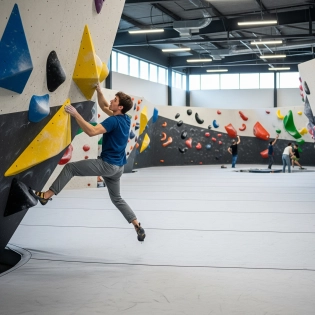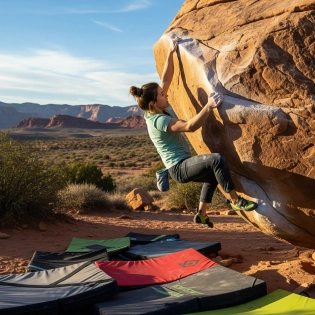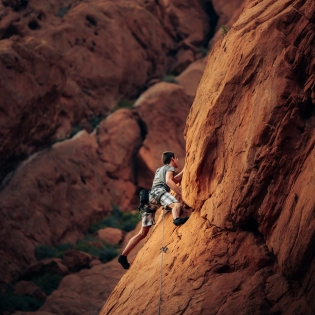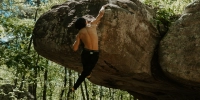







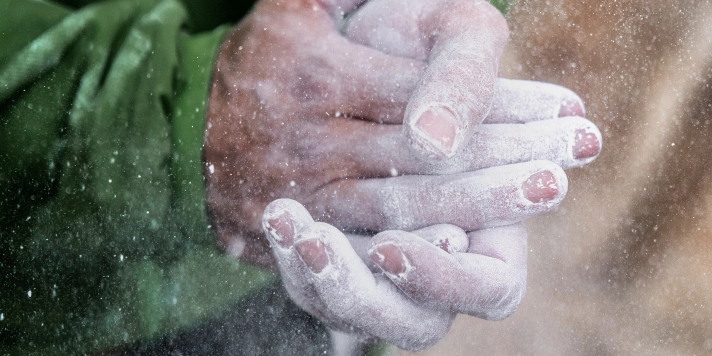
general climbing
Climbers often appear hunched due to the nature of the sport. When climbing, we engage our upper body muscles, particularly the back and shoulders, to maintain balance and stability on the wall. This can lead to a forward-leaning posture, which may give the impression of being hunched. Additionally, climbers frequently need to reach for holds above them, requiring a slight forward lean to generate upward momentum. So, it's a combination of using our muscles and body position that can make climbers seem hunched while on the wall.
Climber's elbow, also known as medial epicondylitis or golfer's elbow, can improve and eventually go away with proper treatment and rehabilitation. It typically involves inflammation or damage to the tendons on the inside of the elbow. The recovery time can vary depending on the severity of the condition, adherence to treatment protocols, and individual factors. Rest, ice, stretching, strengthening exercises, and avoiding activities that exacerbate the symptoms are common approaches to manage and recover from climber's elbow. Consulting a healthcare professional or a qualified sports therapist can provide personalized guidance for your specific situation.
Yes, climbing can contribute to developing a strong and toned physique. It engages multiple muscle groups in your arms, shoulders, back, and core. Regular climbing can help improve strength, endurance, flexibility, and overall fitness. However, achieving a "good body" also depends on other factors such as diet, overall physical activity, and individual genetics.
Climbing at night is not the norm for most climbers, as daylight provides better visibility and safety. However, there are certain situations or specific types of climbing where climbing at night may be preferred or necessary. Here are a few reasons why climbers might choose to climb at night:
Temperature and weather: In hot and arid regions, climbing during the cooler nighttime temperatures can be more comfortable and reduce the risk of heat exhaustion or dehydration. Additionally, climbing at night can help avoid storms or extreme weather conditions that may occur during the day.
Crowds and congestion: Popular climbing areas can become crowded during peak times, leading to long wait times for routes. Some climbers may opt to climb at night to avoid the crowds and enjoy a quieter experience on the wall.
Time constraints: Long multi-pitch climbs or big wall routes can take several hours or even days to complete. Climbers may start these climbs in the evening, aiming to climb through the night and finish the route by morning to stay within their time constraints.
Photography and aesthetics: Climbing at night can offer unique photographic opportunities, especially with a well-lit moon or stars in the background. Some climbers enjoy the aesthetic beauty and the different atmosphere that climbing at night provides.
The strength of the average climber can vary widely depending on their level of experience, training, and natural ability. However, it's important to note that climbing is not solely about brute strength. Climbing requires a combination of strength, technique, balance, and problem-solving skills.
In terms of physical strength, climbers develop strength in their fingers, forearms, back, core, and lower body. Finger and forearm strength are particularly important for gripping holds, while back and core strength help with stability and body control. Lower body strength is utilized for pushing off footholds and maintaining balance.
The average climber typically possesses a moderate level of strength that allows them to tackle routes and problems at a certain difficulty level. With consistent training and practice, climbers can improve their strength and performance over time. It's worth noting that there are climbers with a wide range of abilities, from beginners to elite climbers, each with their own unique strengths and weaknesses.
Climbing can have both positive and negative effects on posture. On the positive side, climbing can help improve your posture by strengthening the muscles that support good alignment. The act of climbing engages various muscle groups, including the back, core, and shoulders, which play a significant role in maintaining proper posture.
By strengthening these muscles, climbing can help you develop a more stable and upright posture. It can also enhance body awareness and control, which can further contribute to better posture both on and off the climbing wall.
However, it's important to note that climbing alone may not be sufficient to address all aspects of posture. Other factors, such as daily activities, work ergonomics, and lifestyle habits, also influence posture. It's crucial to maintain a balance between climbing and incorporating exercises that target the muscles involved in posture, including the upper back, neck, and core.
Additionally, certain climbing positions or techniques, especially if done with poor form or excessive strain, can put stress on the shoulders, neck, and lower back. This can potentially contribute to postural imbalances or discomfort. It's important to be mindful of your body mechanics, maintain proper form, and listen to your body's signals to avoid any negative effects on posture.
If climbing is a sport that you enjoy and are motivated by and it causes you to change your habits and exercise more, then yes, climbing can be a great way to help you lose weight.
Exercise in general is a great way to help you lose weight, but it really comes down largely to your diet. With that said, if you reduce your calorie intake but are not active at all, the journey is going to be less efficient. So both aspects really go together.
Which brings me to my first point. If climbing motivates you to change your habits, improve your lifestyle, eat healthier, and exercise more, then yes, climbing can very much help you lose weight.
I don't know his actual connection to the sport or its origin, but, from the very few videos of him climbing and talking about it, you can see how much he loves the sport.
Jason Momoa is an avid climber. He has been climbing since he was a teenager. The main discipline that he loves is bouldering, as that is also what he started with.
He isn't a stranger to sport climbing either, he has climbed in various locations around the world, including Yosemite National Park. Momoa has talked about how climbing helps him stay physically and mentally fit, and he encourages others to try it too.
He has also incorporated his love of climbing into his acting career by staring in a new docuseries on HBO Max called "The Climb", which he stars alongside his friend Chris Sharma, one of the greatest climbers in the world.
There are a few videos on his YouTube channel specifically about climbing, which further show his love for the sport.
It's great that someone with such an influence like him is able to introduce the sport of climbing to more people.


